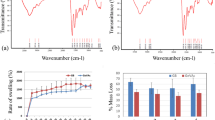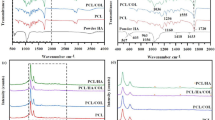Abstract
Polycaprolactone (PCL) has been investigated as an alternative synthetic polymeric scaffold for tissue engineering application. In this study, the biological responses of human adipose-derived mesenchymal stem cells (hADSCs) on PCL-based scaffolds were investigated in vitro. The hADSCs were isolated and characterized. Solvent casting and particulate leaching method was employed as the fabrication method for PCL-based scaffolds. Here, we illustrated that the isolated hADSCs exhibited fibroblast-like morphology, formed colonies in culture, and expressed several stem cell markers. Moreover, the differentiation potency toward adipogenic, neurogenic and osteogenic lineage was noted when cultured in the specific conditions. Polycaprolactone/hydroxyapatite composite scaffold (PCL/HA) supported hADSCs attachment better than PCL scaffolds. Moreover, the alkaline phosphatase enzymatic activity and mineral deposition were greater on PCL/HA than PCL. Together, this present study illustrates the potential utilization of PCL/HA and hADSC for bone tissue engineering.
Similar content being viewed by others
References
GT Huang, S Gronthos, S Shi, Mesenchymal stem cells derived from dental tissues vs. those from other sources: their biology and role in regenerative medicine, J Dent Res, 88, 792 (2009).
H Mizuno, Adipose-derived stem cells for tissue repair and regeneration: ten years of research and a literature review, J Nippon Med Sch, 76, 56 (2009).
EM Horwitz, M Dominici, How do mesenchymal stromal cells exert their therapeutic benefit?, Cytotherapy, 10, 771 (2008).
J Lee, HM Sung, JD Jang, et al., Successful reconstruction of 15-cm segmental defects by bone marrow stem cells and resected autogenous bone graft in central hemangioma, J Oral Maxillofac Surg, 68, 188 (2010).
M Tadokoro, R Kanai, T Taketani, et al., New bone formation by allogeneic mesenchymal stem cell transplantation in a patient with perinatal hypophosphatasia, J Pediatr, 154, 924 (2009).
M Locke, J Windsor, PR Dunbar, Human adipose-derived stem cells: isolation, characterization and applications in surgery, ANZ J Surg, 79, 235 (2009).
LJ Fischer, S McIlhenny, T Tulenko, et al., Endothelial differentiation of adipose-derived stem cells: effects of endothelial cell growth supplement and shear force, J Surg Res, 152, 157 (2009).
LE Flynn, The use of decellularized adipose tissue to provide an inductive microenvironment for the adipogenic differentiation of human adipose-derived stem cells, Biomaterials, 31, 4715 (2010).
T Rada, RL Reis, ME Gomes, Distinct Stem Cells Subpopulations Isolated from Human Adipose Tissue Exhibit Different Chondrogenic and Osteogenic Differentiation Potential, Stem Cell Rev, 7, 64 (2011).
YS Choi, GJ Dusting, S Stubbs, et al., Differentiation of human adipose-derived stem cells into beating cardiomyocytes, J Cell Mol Med, 14, 878 (2010).
S Jang, HH Cho, YB Cho, et al., Functional neural differentiation of human adipose tissue-derived stem cells using bFGF and forskolin, BMC Cell Biol, 11, 25 (2010).
LS Nair, CT Laurencin, Biodegradable polymers as biomaterials, Progress in Polymer Science, 32, 762 (2007).
A Kumari, SK Yadav, SC Yadav, Biodegradable polymeric nanoparticles based drug delivery systems, Colloids Surf B Biointerfaces, 75, 1 (2010).
RS Bezwada, DD Jamiolkowski, IY Lee, et al., Monocryl suture, a new ultra-pliable absorbable monofilament suture, Biomaterials, 16, 1141 (1995).
PD Darney, SE Monroe, CM Klaisle et al., Clinical evaluation of the Capronor contraceptive implant: preliminary report, Am J Obstet Gynecol, 160, 1292 (1989).
B Chuenjitkuntaworn, W Inrung, D Damrongsri, et al., Polycaprolactone/hydroxyapatite composite scaffolds: Preparation, characterization, and in vitro and in vivo biological responses of human primary bone cells, J Biomed Mater Res A, 94, 241 (2010).
E Yoon, S Dhar, DE Chun, et al., In vivo osteogenic potential of human adipose-derived stem cells/poly lactide-co-glycolic acid constructs for bone regeneration in a rat critical-sized calvarial defect model, Tissue Eng, 13, 619 (2007).
PJ Taub, J Yau, M Spangler, et al., Bioengineering of calvaria with adult stem cells, Plast Reconstr Surg, 123, 1178 (2009).
BM Seo, W Sonoyama, T Yamaza, et al., SHED repair criticalsize calvarial defects in mice, Oral Dis, 14, 428 (2008).
Z Zhao, Z Wang, C Ge, et al., Healing cranial defects with AdRunx2-transduced marrow stromal cells, J Dent Res, 86, 1207 (2007).
W Singhatanadgit, N Donos, I Olsen, Isolation and characterization of stem cell clones from adult human ligament, Tissue Eng Part A, 15, 2625 (2009).
T Osathanon, K Subbalekha, P Sastravaha, et al., Notch signalling inhibits the adipogenic differentiation of single-cell-derived mesenchymal stem cell clones isolated from human adipose tissue, Cell Biol Int, 36, 1161 (2012).
T Osathanon, N Nowwarote, P Pavasant, Basic fibroblast growth factor inhibits mineralization but induces neuronal differentiation by human dental pulp stem cells through a FGFR and PLCgamma signaling pathway, J Cell Biochem, 112, 1807 (2011).
T Osathanon, P Ritprajak, N Nowwarote, et al., Surface-bound orientated Jagged-1 enhances osteogenic differentiation of human periodontal ligament-derived mesenchymal stem cells, J Biomed Mater Res A, 101, 358 (2013).
M Neupane, CC Chang, M Kiupel, et al., Isolation and characterization of canine adipose-derived mesenchymal stem cells, Tissue Eng Part A, 14, 1007 (2008).
JJ Mao, DJ Prockop, Stem cells in the face: tooth regeneration and beyond, Cell Stem Cell, 11, 291 (2012).
C Csaki, U Matis, A Mobasheri, et al., Chondrogenesis, osteogenesis and adipogenesis of canine mesenchymal stem cells: a biochemical, morphological and ultrastructural study, Histochem Cell Biol, 128, 507 (2007).
L Cui, B Liu, G Liu, et al., Repair of cranial bone defects with adipose derived stem cells and coral scaffold in a canine model, Biomaterials, 28, 5477 (2007).
L Wang, J Deng, W Tian, et al., Adipose-derived stem cells are an effective cell candidate for treatment of heart failure: an MR imaging study of rat hearts, Am J Physiol Heart Circ Physiol, 297, H1020 (2009).
T Rada, RL Reis, ME Gomes, Distinct stem cells subpopulations isolated from human adipose tissue exhibit different chondrogenic and oteogenic differentiation potential, Stem Cell Rev, 7, 64 (2011).
CS Lin, ZC Xin, CH Deng, et al., Defining adipose tissuederived stem cells in tissue and in culture, Histol Histopathol, 25, 807 (2010).
WY Yeong, N Sudarmadji, HY Yu, et al., Porous polycaprolactone scaffold for cardiac tissue engineering fabricated by selective laser sintering, Acta Biomater, 6, 2028 (2010).
S Kashanian, F Harding, Y Irani, et al., Evaluation of mesoporous silicon/polycaprolactone composites as ophthalmic implants, Acta Biomater, 6, 3566 (2010).
HJ Shao, YT Lee, CS Chen, et al., Modulation of gene expression and collagen production of anterior cruciate ligament cells through cell shape changes on polycaprolactone/chitosan blends, Biomaterials, 31, 4695 (2010).
PM Lopez-Perez, RM da Silva, RA Sousa, et al., Plasmainduced polymerization as a tool for surface functionalization of polymer scaffolds for bone tissue engineering: An in vitro study, Acta Biomater, 6, 3704 (2010).
D Lahiri, F Rouzaud, T Richard, et al., Boron nitride nanotube reinforced polylactide-polycaprolactone copolymer composite: Mechanical properties and cytocompatibility with osteoblasts and macrophages in vitro, Acta Biomater, 6, 3524 (2010).
CG Jeong, SJ Hollister, A comparison of the influence of material on in vitro cartilage tissue engineering with PCL, PGS, and POC 3D scaffold architecture seeded with chondrocytes, Biomaterials, 31, 4304 (2010).
S Fuchs, X Jiang, I Gotman, et al., Influence of polymer content in Ca-deficient hydroxyapatite-polycaprolactone nanocomposites on the formation of microvessel-like structures, Acta Biomater, 6, 3169 (2010).
X Zhang, V Thomas, Y Xu, et al., An in vitro regenerated functional human endothelium on a nanofibrous electrospun scaffold, Biomaterials, 31, 4376 (2010).
W Mattanavee, O Suwantong, S Puthong, et al., Immobilization of biomolecules on the surface of electrospun polycaprolactone fibrous scaffolds for tissue engineering, ACS Appl Mater Interfaces, 1, 1076 (2009).
FJ Xu, ZH Wang, WT Yang, Surface functionalization of polycaprolactone films via surface-initiated atom transfer radical polymerization for covalently coupling cell- adhesive biomolecules, Biomaterials, 31, 3139 (2010).
Y Usui, T Uematsu, T Uchihashi, et al., Inorganic polyphosphate induces osteoblastic differentiation. J Dent Res, 89, 504 (2010).
S Balloni, EM Calvi, F Damiani, et al., Effects of titanium surface roughness on mesenchymal stem cell commitment and differentiation signaling, Int J Oral Maxillofac. Implants, 24, 627 (2009).
TS Silva, DC Machado, C Viezzer, et al., Effect of titanium surface roughness on human bone marrow cell proliferation and differentiation: an experimental study, Acta Cir Bras, 24, 200 (2009).
Z Lu, SI Roohani-Esfahni, G Wang, et al., Bone biomimetic microenvironment induces osteogenic differentiation of adipose tissue-derived mesenchymal stem cells, Nanomedicine, 8, 507 (2012).
MC Phipps, WC Clem, SA Catledge, et al., Mesenchymal stem cell response to bone-mimetic electrospun matrices composed of polycaprolactone, collagen I and nanoparticulate hydroxyapatite, PLoS One, 6, e16813 (2011).
Z Lu, SI Roohani-Esfahni, PC Kwok, et al., Osteoblasts on rod shaped hydroxyapatite nanoparticles incorporated PCL film provide an optimal osteogenic niche for stem cell differentiation, Tissue Eng Part A, 17, 1651 (2011).
Author information
Authors and Affiliations
Corresponding author
Rights and permissions
About this article
Cite this article
Osathanon, T., Chuenjitkuntaworn, B., Nowwarote, N. et al. The responses of human adipose-derived mesenchymal stem cells on polycaprolactone-based scaffolds: an in vitro study. Tissue Eng Regen Med 11, 239–246 (2014). https://doi.org/10.1007/s13770-014-0015-x
Received:
Revised:
Accepted:
Published:
Issue Date:
DOI: https://doi.org/10.1007/s13770-014-0015-x




